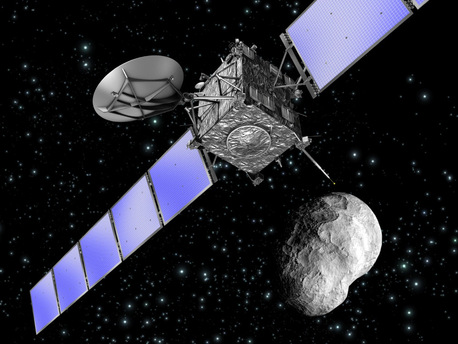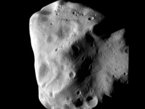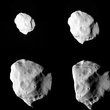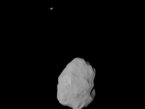Rendezvous with a Planetoid
Heavy Metal Rock Set to Take the Stage
 © ESA
|
This artist's concept represents ESA's Rosetta spacecraft passing by an asteroid. On July 10, the Rosetta spacecraft will pass asteroid Lutetia at a minimum distance of 3,160 kilometers (1,950 miles) and a velocity of 15 kilometers (9 miles) per second. Rosetta will be the first spacecraft to visit an M-class (metal) asteroid.
"Little is known about asteroid Lutetia other than it is about 100 kilometers (62 miles) wide," said Claudia Alexander, project scientist for the U.S. role in the Rosetta mission, from NASA's Jet Propulsion Laboratory in Pasadena, Calif. "Allowing Rosetta's suite of science instruments to focus on this target of opportunity should greatly expand our knowledge of this huge space rock, while at the same time giving the mission's science instruments a real out-of-this-world workout."
Previous images of Lutetia were taken by ground-based telescopes and show only hints of the asteroid's shape. Lutetia will be the second asteroid to receive the full attention of Rosetta and its instruments. The spacecraft previously flew within 800 kilometers (500 miles) of asteroid Steins in September of 2008. The Lutetia flyby is the final scientific milestone for Rosetta before controllers put the spacecraft into hibernation early in 2011, only to wake up in early 2014 for approach to comet 67P/Churyumov-Gerasimenko.
NASA has contributed an ultraviolet instrument (Alice); a plasma instrument (the Ion and Electron Sensor); a microwave instrument (Microwave Instrument for the Rosetta Orbiter); and portions of the electronics package for the double focusing mass spectrometer of the Rosetta orbiter sensor for ion and neutral analysis (ROSINA), among other contributions to this international mission. NASA's Deep Space Network, managed by JPL, will be providing support for tracking and science operations.
One hundred and fifteen elementary school students will be at JPL during the flyby. The students will view close-up images of Lutetia, talk to the U.S. Rosetta project manager and participate in educational activities. The U.S. Rosetta project leaders hope to use this event as a kickoff of more coordinated activities with selected schools around the United States.
source: NASA
Rendezvous with a Planetoid
Heavy Metal Rock Set to Take the Stage
 © ESA
|
This artist's concept represents ESA's Rosetta spacecraft passing by an asteroid. On July 10, the Rosetta spacecraft will pass asteroid Lutetia at a minimum distance of 3,160 kilometers (1,950 miles) and a velocity of 15 kilometers (9 miles) per second. Rosetta will be the first spacecraft to visit an M-class (metal) asteroid.
"Little is known about asteroid Lutetia other than it is about 100 kilometers (62 miles) wide," said Claudia Alexander, project scientist for the U.S. role in the Rosetta mission, from NASA's Jet Propulsion Laboratory in Pasadena, Calif. "Allowing Rosetta's suite of science instruments to focus on this target of opportunity should greatly expand our knowledge of this huge space rock, while at the same time giving the mission's science instruments a real out-of-this-world workout."
Previous images of Lutetia were taken by ground-based telescopes and show only hints of the asteroid's shape. Lutetia will be the second asteroid to receive the full attention of Rosetta and its instruments. The spacecraft previously flew within 800 kilometers (500 miles) of asteroid Steins in September of 2008. The Lutetia flyby is the final scientific milestone for Rosetta before controllers put the spacecraft into hibernation early in 2011, only to wake up in early 2014 for approach to comet 67P/Churyumov-Gerasimenko.
NASA has contributed an ultraviolet instrument (Alice); a plasma instrument (the Ion and Electron Sensor); a microwave instrument (Microwave Instrument for the Rosetta Orbiter); and portions of the electronics package for the double focusing mass spectrometer of the Rosetta orbiter sensor for ion and neutral analysis (ROSINA), among other contributions to this international mission. NASA's Deep Space Network, managed by JPL, will be providing support for tracking and science operations.
One hundred and fifteen elementary school students will be at JPL during the flyby. The students will view close-up images of Lutetia, talk to the U.S. Rosetta project manager and participate in educational activities. The U.S. Rosetta project leaders hope to use this event as a kickoff of more coordinated activities with selected schools around the United States.
source: NASA








